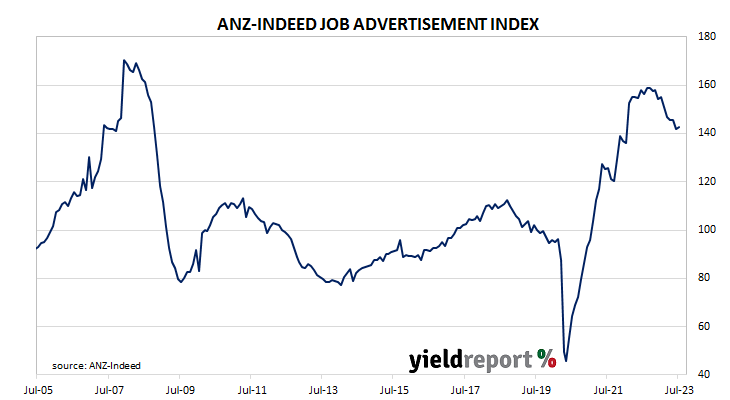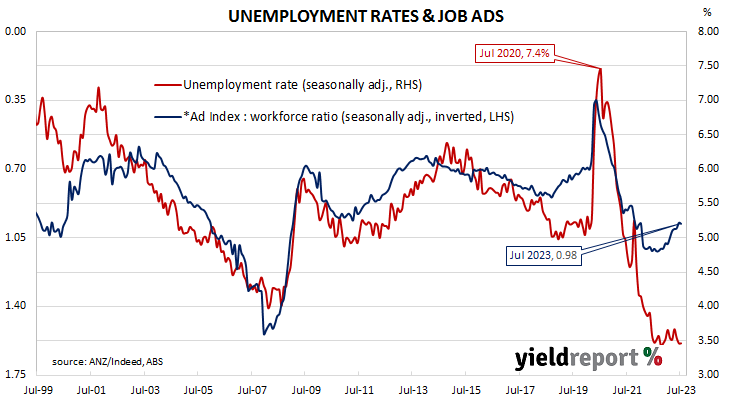Summary: Job ads up 0.5% in July; 8.8% lower than July 2022; July lift likely a blip; ACGB yields down considerably following large US falls; rate-change expectations barely move; other signs labour market momentum starting to slow; ad index-to-workforce ratio rises to 0.98.
From mid-2017 onwards, year-on-year growth rates in the total number of Australian job advertisements consistently exceeded 10%. That was until mid-2018 when the annual growth rate fell back markedly. 2019 was notable for its reduced employment advertising and this trend continued into the first quarter of 2020. Advertising plunged in April and May of 2020 as pandemic restrictions took effect but then recovered quite quickly to historically-high levels.
According to the latest ANZ-Indeed figures, total advertisements rose by 0.5% in July on a seasonally adjusted basis. The result followed a 2.7% loss and a 0.1% gain in June and May respectively. On a 12-month basis, total job advertisements were 8.8% lower than in July 2022, up from June’s revised figure of -10.3%.
“ANZ-Indeed Australian Job Ads rose a touch in July,” said ANZ economist Madeline Dunk. “But the series has fallen 2.1% over the past three months, suggesting the July lift is likely to be a blip.”
Commonwealth Government bond yields fell considerably on the day, largely following movements of US Treasury yields overnight. By the close of business, the 3-year ACGB yields had shed 10bps to 3.77% while 10-year and 20-year yields both finished 12bps lower at 4.07% and 4.38% respectively.
In the cash futures market, expectations regarding further rate changes hardly changed. At the end of the day, contracts implied the cash rate would rise from the current rate of 4.07% to average 4.085% in September and then to 4.115% in October. February 2024 contracts implied a 4.20% average cash rate while May 2024 contracts implied 4.175%, around 10bps more than the current rate.
Dunk also noted “other signs labour market momentum is starting to slow as the RBA’s 400bps of hikes flow through to economic activity”. She pointed to NAB’s June quarter Business Survey and the smaller proportion of firms which had had reported labour as a constraint on output.
The inverse relationship between job advertisements and the unemployment rate has been quite strong (see below chart), although ANZ themselves called the relationship between the two series into question in early 2019. A lower job advertisement index as a proportion of the labour force is suggestive of higher unemployment rates in the near future while a rising ratio suggests lower unemployment rates will follow. July’s ad index-to-workforce ratio increased from 0.97 in June to 0.98 after revisions.
In 2008/2009, advertisements plummeted and Australia’s unemployment rate jumped from 4% to nearly 6% over a period of 15 months. When a more dramatic fall in advertisements took place in April 2020, the unemployment rate responded much more quickly.



